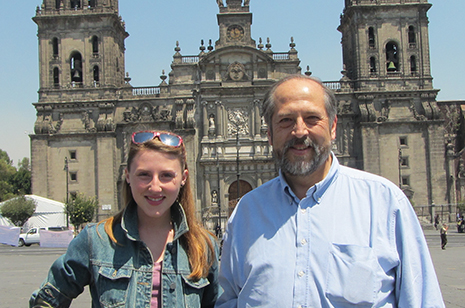Drought Contributed to Typhus Epidemics in Mexico from 1655 to 1918, Study Shows

Jordan Burns and Rodolfo Acuna at the Zocalo, the central square in the heart of historic downtown Mexico City.
FAYETTEVILLE, Ark. – Epidemiological data integrated with climate data taken from tree-ring estimates of soil moisture levels demonstrate that drought contributed to the spread of typhus in Mexico from 1655 to 1918, according to a new study by researchers at the University of Arkansas.
The study has modern-day policy implications because although typhus can be treated with modern antibiotics, it remains a threat in remote, impoverished areas of South America, Asia and Africa and could reemerge as a serious infectious disease, especially where social strife and underdeveloped public health programs persist.
The researchers describe their findings in an article published Feb. 11 in Emerging Infectious Diseases, a Centers for Disease Control and Prevention journal that tracks and analyzes disease trends.
“Historical records show that typhus has traditionally accompanied war, famine and poverty,” said David Stahle, a Distinguished Professor of geosciences. “Now, because of Mexico’s rich historical record of epidemic disease, we can see that drought, as reconstructed by tree-ring chronologies, caused conditions that allowed typhus to flourish in central Mexico over a 250-year period.”
Stahle and Jordan Burns, a graduate student in geography at the U of A, compared historical records of 22 typhus epidemics in central Mexico with soil moisture estimates based on tree-ring reconstructions. They analyzed data gleaned from almanacs, diaries and personal accounts, as well as medical and death records from hospitals, physicians, cemeteries and municipalities. They compared this with instrumental data for the Palmer Drought Severity Index, or PDSI, an index of the effects of temperature and precipitation on soil moisture dating back to 1895.
Burns, Stahle, and their collaborator Rodolfo Acuna, a professor of microbiology at the National University in Mexico City, observed a significant relationship between periods of drought and famine in rural, agricultural regions of central Mexico. Below-average tree growth, drought and low crop yields occurred during 19 of the 22 typhus epidemics.
“The observed relationship between drought and typhus epidemics in colonial and modern Mexico is curious because drought has not been specifically considered a risk factor for typhus,” Burns said. “But drought, much like war and natural disasters, caused famine in poor, agricultural regions and forced impoverished refugees to move into already crowded urban areas where infrastructure and sanitary systems were insufficient.”
Epidemic typhus is an infectious disease caused by a bacterium transmitted between people by body lice. The disease spreads where conditions are crowded and unsanitary. It is recognized for its high mortality rate throughout human history, particularly before modern sanitary practices and the availability of antimicrobial drugs. Despite these advances, the disease persists in some areas of Africa, South America and Asia and has not been eliminated from industrialized regions, because body lice infestation still occurs in homeless populations of Europe and the United States.
For more than 30 years, Stahle has taken core samples from trees and examined the chronology of their rings to help explain the societal impact of drought and other climate changes. Specifically, his research has added rich information to explanations about the migration of North America’s indigenous people and the demise of Mesoamerican civilization.
Stahle’s recently published 1,238-year-long tree-ring chronology, the longest and most accurate of its kind for Mesoamerica, was the first to reconstruct the climate of pre-colonial Mexico on an annual basis over a period of more than a thousand years. That study identified four ancient megadroughts and their exact years. Previous research found large and epic droughts in North America during the eighth and 16th centuries.
Topics
Contacts
Jordan Burns, research assistant, geosciences
J. William Fulbright College of Arts and Sciences
479-575-3703,
jnb001@uark.edu
David Stahle, Distinguished Professor, geosciences
J. William Fulbright College of Arts and Sciences
479-575-3703,
dstahle@uark.edu
Matt McGowan, science and research communications officer
University Relations
479-575-4246,
dmcgowa@uark.edu
Headlines
PetSmart CEO J.K. Symancyk to Speak at Walton College Commencement
J.K. Symancyk is an alumnus of the Sam M. Walton College of Business and serves on the Dean’s Executive Advisory Board.
Faulkner Center, Arkansas PBS Partner to Screen Documentary 'Gospel'
The Faulkner Performing Arts Center will host a screening of Gospel, a documentary exploring the origin of Black spirituality through sermon and song, in partnership with Arkansas PBS at 7:30 p.m. Thursday, May 2.
UAPD Officers Mills and Edwards Honored With New Roles
Veterans of the U of A Police Department, Matt Mills has been promoted to assistant chief, and Crandall Edwards has been promoted to administrative captain.
Community Design Center's Greenway Urbanism Project Wins LIV Hospitality Design Award
"Greenway Urbanism" is one of six urban strategies proposed under the Framework Plan for Cherokee Village, a project that received funding through an Our Town grant from the National Endowment for the Arts.
Spring Bike Drive Refurbishes Old Bikes for New Students
All donated bikes will be given to Pedal It Forward, a local nonprofit that will refurbish your bike and return it to the U of A campus to be gifted to a student in need. Hundreds of students have already benefited.




